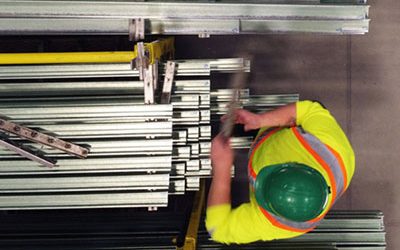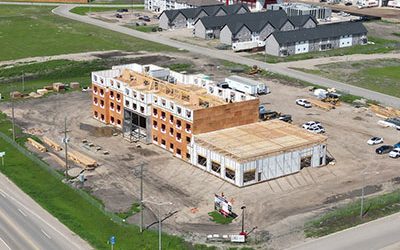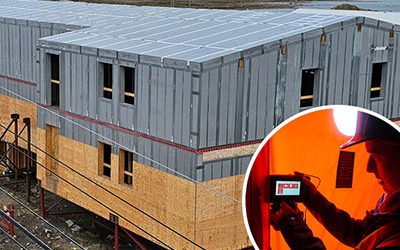The ICE Panel is still a relatively new building product, which means there are still a lot of questions. Misconceptions and assumptions about this newer building solution can also lead to misinformation or “myths” being spread about a fairly simple product that are factually incorrect. Let’s take a look at 7 common myths surrounding the ICE Panel:
Myth #1: ICE Panels are not fire resistant, and will create toxic fumes in a fire.
Reality: ICE Panels do not contribute fuel to a fire. ICE Panels can be used in a 1-hour fire rated load bearing assembly, or a 2-hour non-load bearing assembly. The Expanded Polystyrene (ie. EPS) used in ICE Panels is expanded using steam. In a fire, the smoke that develops from the EPS melting is less toxic than smoke from a lumber fire.
Myth #2: ICE Panels will blow over in a strong wind.
Reality: ICE Panels properly assembled are stronger than conventional framing. Screws in the engineered steel frame assembly resist pull-out better than nails in lumber, and the EPS between the steel framing acts like bracing with memory. Under severe conditions, if the wall is deflected, the foam will help the building return to it’s original shape. Due to this, the ICE Panels have proved structurally resistant through several hurricanes in the United States and the Bahamas. During the construction of an ICE Panel home in the Bahamas, the project experienced Hurricane Dorian. It resisted 285 kph winds and a 20′ king tide. It wasn’t until a 40′ shipping container that was picked up by the waves and slammed into the building repeatedly, that the building eventually sustained some damage.
Myth #3: ICE Panels are not environmentally friendly.
Reality: While EPS and steel framing on their own can be carbon intensive, it’s assumed that ICE Panels are not environmentally friendly. Due to how ICE Panels are configured, they can In fact significantly reduce a projects carbon footprint.
The steel framing in ICE Panels is braced using EPS. The EPS core is bonded and mechanically fastened to the steel frames. This means that compared to traditional light gauge steel framing, ICE Panels require significantly fewer pounds of steel to create a comparable structural performance.
EPS offers one of the shortest carbon offset periods available, due to the significantly reduced consumption of oil and gas to heat the building. A home built with ICE Panels will require less energy to hold a comfortable air temperature, thus reducing your carbon footprint.
EPS is 96-98% atmospheric air with an incredibly long life cycle, making it one of the most environmentally friendly high performance building insulations on the market today. In addition to that, our manufacturing plant is a zero-waste facility, meaning any unused materials are 100% recycled.
Myth #4: ICE Panels are too expensive.
Reality: When comparing ICE Panels to the cost of traditional materials, the price will be higher. However, benefits such as reduced on-site garbage, fewer trips to the dump, less tipping fees, lower construction heating cost, shorter time to occupancy, and fewer problems on site due to pre-construction 3D modelling are hard to quantify. Taking these additional factors into consideration, ICE Panels are not only a high performance solution, but also an economically competitive one. By choosing to build with ICE Panels, you are investing in a high performance building.
Myth #5: ICE Panels will result in a cold indoor space due to the steel framing.
Reality: People often associate steel with cold temperatures, but that is due to thermal bridging. ICE Panels are manufactured with a double wall steel frame assembly with no thermal bridging. ICE Panels are thermally broken and provide incredibly high effective R-values making it one of the highest performing wall assemblies on the market today.
Myth #6: Rodents or pests will easily chew through ICE Panels.
Reality: Rodents and pests burrow into spaces where there are noticeable traces of heat and nourishment (like decaying lumber). ICE Panels eliminate thermal bridging which means there is no noticeable heat loss to the building exterior. This leaves rodents and pests no reason to force entry to the building. As an additional preventative measure, a waterproof membrane is used below grade and to a minimum of 6″ above grade.
Myth #7: Steel isn’t a sustainable building material.
Reality: Steel is the most recycled material in the world. More than 80 million tons of it is recycled per year, That’s more than the annual combined total of paper, plastic, aluminum, and glass. More than 90 percent of steel is recycled into another steel product, using far less energy than was necessary to create it in the first place. A material that can be recycled continually over decades with no loss in quality and that lowers the burden on future generations is the definition of sustainability.
We hope this blog cleared up a few of the common questions relating to ICE Panels.
Curious about ICE Panels? Give us a call at 204-726-1426 or send us an email at sales@gsbp.ca to get your project started.



